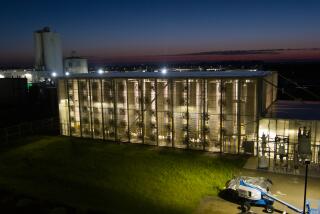Up, Up and Away
Laws are made to be broken. Or so the National Aeronautics and Space Administration seems to think. After an almost two-year wait, the agency’s Marshall Space Flight Center in Huntsville, Ala., is poised to take delivery of a machine that proponents hope will counteract the laws of gravity.
At the heart of the device is a purported effect so radical it could change the way we interact with one of nature’s most fundamental forces. We’re talking revolution, not evolution. A revolution in spaceships would be just one spinoff. Back here on Earth, the internal combustion engine could become an endangered species, replaced by gravity-powered cars, planes and elevators.
The dream of defying gravity has a long and ignoble history. From Icarus on, the road is littered with failed attempts to unbind our feet from the shackles of nature’s most seemingly inexorable force. But the team behind the NASA project say they are basing their efforts on real science, and NASA has paid almost $600,000 to have the machine custom-built by Ohio-based Superconductive Components, Inc. (SCI), a company that specializes in high-tech ceramics and superconducting materials. Says SCI Vice President James R. Gaines Jr.: “If it works, what a hoot!”
Revolutions are usually bloody affairs, and this one is no exception. Many physicists believe the whole project is a waste of time based on unsubstantiated research of dubious origin. Gravity, they contend, is in no danger of diminution--the only thing they see at stake is NASA’s credibility.
The story begins soberly enough, in the pages of the respected science journal Physica C. There, in 1992, Russian physicist Evgeny Podkletnov published the results of an experiment in which he claimed to have discovered a “gravity-shielding” effect. According to the article, Podkletnov had managed to reduce the force of gravity on a small object by up to 2%--in effect, he had reduced its weight. Now 2% may not sound like much, but to the physics community, it was like a bomb blast. The law of gravity is one of science’s most sacrosanct principles; any breaching of its walls would represent a major threat to the current theoretical framework. If verified, such a finding would bag its discoverer a Nobel Prize.
But here’s the rub: Podkletnov’s paper was hazy on the details. He worried that his ideas would be taken by others, that he would not be given proper credit, and he refused to allow anyone into his lab to see his apparatus. Incomplete disclosure, coupled with the outlandish nature of the claim itself, left most physicists scoffing with derision. As a result, Podkletnov was thrown out of his job at the Tampere University of Technology in Finland.
Since his paper appeared a decade ago, Podkletnov says, many people have successfully replicated his results, but if so, they have yet to report them in a peer-reviewed journal. All those who have published have failed to detect any clear results. One of them is Marshall Space Flight Center researcher Ron Koczor, who spent two years investigating various aspects of Podkletnov’s experiments, and eventually gave up. But Podkletnov insists the gravity-shielding effect only occurs when all the experimental conditions are precisely right. Koczor decided it was a job for the professionals, and in 1999 he persuaded NASA to commission SCI to build a facsimile of Podkletnov’s original apparatus.
The details might be sketchy, but the basic idea behind the device is fairly simple. It begins with a disc, about six inches in diameter and a quarter of an inch thick, made out of a superconducting material whose recipe Podkletnov has carefully kept secret. The disc is cooled to below -233 degrees centigrade and levitated using a magnetic field. Then an electric field is applied to make the disc spin. So far, all we have is a variation on an electric motor, but Podkletnov claims that when the disc rotates at more than 5,000 revolutions per minute, an object placed above it begins to lose weight. Somehow, he says, the force of gravity is being counteracted--the trick is, you have to get the setup exactly right.
“I wish it was as simple as baking a cake,” says SCI’s Gaines. Even with the company’s expertise it has not been easy. Indeed, the project is a year behind schedule. But Gaines says his team are almost there, and they should be handing over the device to NASA soon.
Will it work? Gaines’ technicians are not gravity experts; their field is materials science. They have simply built the machine to agreed specifications. But, of course, they would be thrilled if it did work; success would ensure an enormous boost to superconducting research. Testing of the device will be NASA’s responsibility, and he awaits their results with great expectation.
Personally, I am thrilled to hear my tax dollars are hard at work subverting the laws of nature. Or attempting to, at any rate. Who knows what conceptual mountains we might demolish if our imaginations aim high enough? Johannes Kepler, the founding father of modern astrophysics, saw science as a form of play--empirical data set an irrevocable boundary to this play, but within its arena the imagination must be free to roam.
This is not NASA’s first attempt to look for the Podkletnov effect. Last year, Marshall Space Flight Center funded a different experiment in which a very sensitive Cavendish balance was used to try and detect a change of weight in a superconducting apparatus. Results of that study were “inconclusive.”
Randall Peters, a physicist at Mercer University in Macon, Ga., was a consultant to that project--he helped to customize the balance for this unorthodox use. “My own position,” Peters says, “is that I’d be greatly surprised if the effect being sought was actually found.” Like most physicists, he feels confident that gravity will withstand the Podkletnov test. Nonetheless, he adds that “physics is full of surprises,” and he believes that scientists need to maintain an open mind. Gaines agrees, defending NASA’s willingness to go out on such a speculative limb: “The upside potential is so huge, they really couldn’t afford to miss out if it is true.”
NASA’s interest in circumventing gravity is not theoretical. The agency is reaching for the stars. Literally. Even in the zero-gravity environment of outer space, you still need to accelerate a ship to extremely high speeds to get to the stars in any viable framework, something that cannot be done with conventional rocket technology. The Podkletnov effect suggests it may be possible to effectively reduce the mass of the ship, thereby reducing the overall energy needed for acceleration.
The authors of the July paper introduced their experimental analysis with a wistful discussion on the limitations of rocket propulsion. “Using current rocket technology,” they note, “a trip to the next star would easily consume the mass-energy equivalent of a planet in order to arrive within a reasonable lifetime.” Technologies like nuclear fission and fusion offer some hope, “but still will not support the ‘Star Trek’ vision of space exploration.” In short, if we are serious about space travel, we need a quantum leap forward in propulsive power.
Investigating potential options is the task of NASA’s Breakthrough Propulsion Physics Project, which funded last year’s Cavendish balance experiment. Then headed by aerospace engineer Marc G. Millis, the BPP group has license to boldly go where no man has gone before--to the outermost limits of current scientific understanding. Speaking by phone from his office at the John H. Glenn Research Center in Ohio, Millis insists that “we’re not asking anyone to develop a warp drive.” NASA understands, he says, that this is going to take time, and he stresses that they are “interested in developments of short increments.” Giant spikes of speculation are to be sheathed in favor of careful step-by-step progress.
Specifically, the BPP is seeking projects that can be feasibly achieved in two to three years. Already, the office has funded five projects that investigate anomalous physical effects. Most do not deal with gravity per se; as Millis notes, “modifying gravity” is just one possible direction from which to approach the propulsion problem. The group has also funded work on reducing the effect of inertial mass, on quantum tunneling and on the relationship between electromagnetism and space-time. Well aware of the threat to NASA’s reputation, he is determined to encourage only the most clean-cut suitors, people with university affiliations and the like.
But lightness of being is a dream that transcends institutional boundaries and beyond the ivory towers of academe an unheralded army of amateurs are beavering away in their basements against the unbearable restraints of Isaac Newton’s laws. Go online and the virtual ether fizzes with a thousand competing propulsion systems. James Cox, editor of AntiGravity News, lists no less than seven major classifications of anti-gravity devices, from those based on superconductivity, to those that exploit properties of gyroscopes and purported anomalies in nuclear physics or quantum mechanics. Cox himself is working on an anti-gravity backpack that he claims is nearing the patent stage. He is currently seeking funding to develop a commercially viable prototype.
When the BPP’s next casting call goes out in the fall, Millis says the agency will keep an open mind. The message of history, he says, is that new insights can come from the most seemingly unlikely directions. By definition, no one can predict from whence the next revolution will arise. Gentleman, start your engines.






